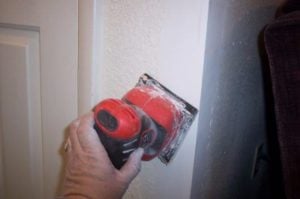Sanding drywall is a very easy task to complete, that’s until you get to the corners. Throughout the room the process isn’t that bad, but many people seem to get frustrated to the point they want to give up when it’s time to sand the corners. Most power sanders such as an orbit sander is impossible to get the corners just right which is why it’s time to improvise, or at least consider something entirely different.
The idea of sanding drywall corners is much more difficult than it seems, but only when you have a true understanding of what not to do. After you’ve taken the time to tap the seams and mud the corners, it’s time to sand so you can put on your own final touch.
What Equipment to Consider First?
One of the first things to consider when sanding inside drywall corners is what type of sanding technique such as manual or power. Most people elect to go the old fashioned route as it gives the user more control, but of course, it will take longer. Using a sanding block is most people’s first choice and then finishing it up with a pole or hand sander will give blended look.
For the roughest parts, using something as simple as a taping knife is much better suited. Knocking off the ridges will give you more of a consistent surface to start sanding. Next, an inside corner or outside corner tool can be used. These can be picked up from your local hardware store for as little as $20, and may be a wise investment if you are planning on doing more than one room in the house.
The corner tools are built in a manner that fit perfectly in the joints of the drywall corners that typically come together in a 90-degree angle. If you’re intending on using a knife, we highly recommend using a one that is 12 – 14 inches versus a smaller 4″ knife.
After Manual Sanding, Dremel or Pole Sand the Rest
After knocking down the roughest parts of the corners, consider finishing it off with a Dremel tool. A Dremel tool can be used for many sanding and grinding tasks and finish sanding drywall corners is one of its specialties. The tool itself has multiple attachments which can be used for various locations and projects and has become one of the most popular handyman tools in the shed.
If you choose, using a pole sander is another great option as it allows you to reach those tough locations including ceiling corners. A pole sander is a type of hand sander which literally acts as an extension of what you can hold in your hand. This of course is a manual process, and using a combination of sandpaper grits from course to fine will do the trick.
Something to consider with using a pole sander is that it can cause blemishes and nicks in the wall itself. When sanding along the plane of one wall, the edge of the sander which is attached to the pole has a tendency to brush up against the opposite wall. Just be careful when pole sanding the corners as it can definitely lead to a whole lot of frustration, and unnecessary work.
Sanding drywall can cause a great deal of drywall dust, but there are plenty of things that you can do to minimize this.





